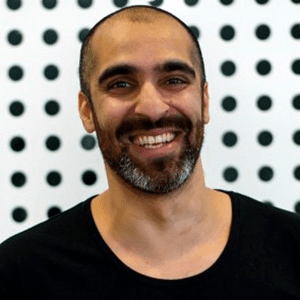

#2: Innovation demystified – how, why and when should business leaders innovate
Stephen Rutter, Founder of The Scale Institute is demystifying the latest buzzword. What does innovation look like for business and where do you start? Innovation can be as simple as changing processes to solving complex problems or driving transformational change for business.
Stephanie: Today I’m talking to Stephen Rutter. Stephen has a really interesting background. In fact, at 32, he tells me he had to manage himself out of a great job. He built a business unit to 33 million dollars in annual turnover, that managed the logistics of all the Hollywood productions that were shot in Australia. And he says that traveling to L.A. every two months took its toll.
So what did he do? He really needed an MBA to transition into a proper job after the entertainment industry. And he found himself disappointed with the relevancy of his tertiary education. He knew that that system could really be improved and that’s part of the journey he is on now, to bring curiosity back into the learning experience.
His most recent corporate experience was as founding Head of Experience at Sydney School of Entrepreneurship, a 25 million dollar initiative of the New South Wales Government to see next generation entrepreneurship. And now? Stephen has spent the last year building his own education consultancy, The Scale Institute. Where he and his peers are designing innovative learning strategies and product development opportunities with a varied group of clients across Australia, including universities, large corporates, and quite a specialist actually in the SME market.
So Stephen, welcome.
Stephen: Thank you.
Stephanie: And, who’s the most interesting celebrity you met?
Stephen: A lot. However, I’d like to say that my most favourite client was actually Shane Warne. Yeah. And I say that, not for his off-field endeavours…but, first guy that would come up and thank me for a good job that I did for him. Second, he remembered my name, which took a personal tone to it. And third, would also open his wallet at the bar and buy you a drink.
Stephanie: I bet he did.
Stephen: And a lot of celebrities have not done that.
Stephanie: Because they’ve got their people around them.
Stephen: And also the air of arrogance that, you know, they are different to everyone else.
Stephanie: Yeah. Interesting. I could talk for this whole conversation about your Hollywood experience. Now, I’d love to get into the whole conversation about innovation.
It’s a word that is just, you know, post-disruption now it’s innovation. So let me put this to you, that everyone feels they should be doing it. Probably guilty if they’re not. It’s a bit of a mystery. How do you start with a business leader who knows they need to or wants to innovate, but doesn’t know where to begin?
Stephen: I actually ask them to self reflect on their past and present initiatives that they’re conducting because they’re actually already doing it.
Stephanie: Okay. Tell me more about that
Stephen: They just don’t know it. So I use analogy of putting a mirror up in front of them to be able to take the time and effort away from their business to work out where the future holds for their sustainability. So the idea is if they can actually identify what they’re good at, then they just need to focus on the good stuff and keep going and creating more value.
Stephanie: So is innovation doing the same thing in new ways and better or is it doing something different?
Stephen: It’s both. However, it’s a form that I really put my hat in the ring and say it’s a new way of doing existing things…that create more value.
Stephanie: Right, okay. So where do you start?
Stephen: So, I think first of all with innovation you do an audit. So, I call it an innovation health check. So I’m doing that with a couple of existing clients right now. And we do that in primary research where’d there’d be universal surveys to really identify where on the spectrum they are in innovation. And that allows us and also them because its all about a co-design process. So, when I’m conducting a consultancy for new learning strategy, I bring the CEO or the sponsor on board, get them involved every week in a stand-up, which is a funky word for a meeting.
Stephanie: You’ve tried to involve me in stand-ups, Steve, and then your problem is I sit down.
Stephen: Yeah. And you know, but that’s okay because we want rule breakers. So, if I want someone to stand up and they’re more comfortable and they will give me more value sitting down, go for it.
Stephanie: Right, that’s good to know. So back to what you were saying ..so you start with the health check. You’ve always got to sort of understand where you are. Yep.
Stephen: Yeah. So, you start with the health check and then you map that to the existing environment ecosystem that they’re within. The whole process around that is to really bring back the business strategy 101. I think if I can just step back and talk about what is innovation, it’s actually demystifying that innovation is already in our DNA, we just need to get back to the fundamentals of focusing on the user and really looking at what the real problems we’re solving are.
And I think if you allow yourself those two lenses, then everything else gets simplified. Because we don’t talk about disruption, we don’t talk about the wave of Blockchain or artificial intelligence or things like that because that’s really just a means to get your new product or service into the market.
Stephanie: Yeah. Everything doesn’t have to be virtual.
Stephen: Totally. And because in the whole innovation process when we start to test our assumptions, we do that in a manual form. So we call that a paper prototype. The idea that is that once we’ve done our research, we’ve done the innovation health check, we’ve spoken to the stakeholders, we’ve started to really understand their, in no better term, pains and gains that they’re going through, then you can actually test those assumptions, that you come out of that market research phase in, and the easiest way to do that and the cheapest way to do that is in the rudest form possible which is called a minimum viable product.
Stephanie: Yeah. And what does that mean?
Stephen: So this could be a webpage, it could be a fancy poll on your LinkedIn or your Twitter account to go, ‘Would you engage with this type of product offering, yes or no?’. And if you get 1000 responses in 15 minutes saying no, well, chances are you probably shouldn’t spend another dollar on it.
Stephanie: And I love that idea, because it’s quite the opposite of perhaps what people might commonly think you have to build a fantastic product, you’ve got to have a really cool, new product. And that’s innovation. So you’re saying, you’re actually saying you start with the customer.
Stephen: That’s exactly right. So the idea is that you don’t go too far down the rabbit hole to realise that I’ve just probably sunk in $150,000 into this new opportunity and you know what? No one wants it. But, they spend another $250,000 because the ego gets in the way.
Stephanie: You’ve seen that happen?
Stephen: Yeah. So they can’t actually make the, I guess, constructive decision to back out because they will lose face.
Stephanie: Yeah. And it’s their baby.
Stephen: And it’s that five-year mentality that sucks in the Australian culture. We don’t embrace it.
Stephanie: So what you’re saying then is flipping it, and building a minimal viable product and testing it?
Stephen: Yes. And then we could do five of them at once. Because we’ve just saved the initial product development fee for later on in the innovation process and we test five. And jury states that four out of five will fail. But hopefully we get that gold nugget.
Stephanie: You find the good one. So there must be a testing phase, I guess, as you’re going through this and then at some point you say, well were going to invest in this one, we think this one has legs.
Stephen: Yeah. That’s exactly right. So, then we actually adopt the traditional business planning process. I think the fifty-page business plan is well out the window….But they talk about this one-page business model canvas. Or other iterations or lean canvas or a social impact canvas, really depends on what you’re potentially building out. But it allows that lean methodology to still be in the business strategy process to identify how quickly you can either move on a particular product or service or testing phase at that time.
Stephanie: Okay. So, I’m the CEO of a small business. I’ve got a lot of stuff happening every day. And I’ve got people coming in and leaving or seek or something wrong with my distribution channel. Where do I find time to innovate? How do I do this?
Stephen: They don’t because they don’t actually prioritise or value learning…How I’ve come to that conclusion is that as you rightly pointed out, Steph, BAU, business as usual gets in the way, they’ve got too much stuff going on to even talk about taking either their own self, their employees, or even their customers, on the learning journey. So they actually just discount it and they believe that the way we’ve been doing things around here for the last five, ten years is what we can actually do going forward.
But what has happened, the market has changed. The mobile phone that we all have has allowed the market size to go from a significant demographic or geographic context to a market size of one. So the customers got the power to choose what they buy into and what they don’t. So I think firstly, obviously, to re-frame what innovation is and innovation should be a learning pathway for your business to accelerate their growth. So if you can actually bring learning into the organisation as a core pillar of their strategic intent, then you’ve actually started the growth mindset. Because that is what learning is.
Stephanie: So, and I think you’re right about priorities. Isn’t it? Because you could even have the intention of we’ve got a great ambitions for this business, you know it’s rare to find a business owner or a business leader who says ‘enough, we’ll stop now’. So I’ve got great ambitions but it just keeps coming. Regulatory changes or technology changes or people changes or, you know, all the things that… cash, time. So how can a business owner engage their team in innovation? Where have you seen that work well?
Stephen: So based on my last seven years in educational institutions and helping out corporate’s innovate, I call it agile innovation, adopting a startup approach. What I actually do, I get them in straight away and I tell them to demystify the innovation process and chuck all the buzz words out the window. Cause we label them all so often. But the idea around that is that there is a need for companies to provide a safe and open and relaxing space for people to innovate. So, all that is required is time. Okay, and if you look at the big global tech startups that are now the top five learning organisation in the world.
They have 15 to 25% of their time provided to their employees to go and learn. That’s not go and do your administration, go do your tax receipts and things like that. That’s actually go and do something but take that lesson point, do something totally different to your current job role, because we don’t want to see you do more of the same. We want you to bring outside experience into your day job. And that’s again, creating value from something new. So it’s really down to the time and space.
Stephanie: Back to what you were saying about the agile and startup methodology approach. So how do you apply that, well, how could, you know not jumping into your methodology chapter and verse. But, how could a business leader adopt that then with their people?
Stephen: So, they would take them through a cycle of workshops and I’ll give you a buzzword, they call them sprints. Okay, so they take them through sprints that really start with focusing on the problem. So, and obviously with a problem there’s always someone that owns that problem. And that’s traditionally either a user or a customer. But you could also put the lens of an employee or the boss…in that, because we want to solve that. So we really want to understand how they are feeling and what they’re going through. And what, you know, it’s a cliché, but what keeps them awake at night. Cause once we identify their frustrations, then opportunities arise. So then, we can then really start to build out a solution.
And when we talk about the solution, we can talk about a process improvement, a policy change, a new product or service, or just a new way of doing things in the office. You know. Let’s chuck a soft toy around to each other in our meetings and whoever has the soft toy has the floor, no one else talks when they’re talking. It’s a simple technique but it actually builds a lot of trust and respecting teams. Because it’s not the person with the highest paycheck or the person at the front of the boardroom table that is the most relevant to answer that decision.
Stephanie: So, you’re talking about culture and you’re talking about good leadership. I mean, you’ve used the word trust which is at the heart of both of those things and about the leader passing, you know, not being a one man band.
Stephen: Totally. So, we need to actually democratise the leadership process. And that takes a brave, vulnerable, and authentic leader to adopt that.
Stephanie: To then be able to, I guess, foster and innovative culture.
Stephen: Yes, so if I can take the realisation that startups turn into companies. So the definition of a startup is a temporary organisation, because 94% of them statistically will fail. So they will build into an organisation and then scale up and become a large organisation. So, they’re struggling with all the bureaucratic processes that I love to hate. But the large organisations have the customers, the resources, the real ability to operate at scale. So there needs to be that merge and that’s where corporate venturing comes into play. But it never works because culture just doesn’t fit. And you know, there’s been some great examples, but a lot of poor ones. And I think the idea is these scale-ups have really organised in high performing teams.
So project teams…such as HR legal finance that we’re all accustomed to. But what the projects are, at that time and space, to get the job done. And you’ll hear that a lot in the coming years. What’s our job to be done?
Stephanie: Yeah. That’s Christensen, isn’t it?
Stephen: Yeah. Clayton Christensen has really taken that onboard and that’s a simplistic way of understanding what is your purpose for your customer? And once you realise that, people, whether they’re internal or external to the organisation, will buy into your process.
Stephanie: So that idea of jobs to be done, takes away from starting with the function.
Stephen: That’s right.
Stephanie: Well I’m a marketing manager, therefore, this is my job.
Stephen: That’s right.
Stephanie: Well you’d start with a customer, wouldn’t you?
Stephen: Well, yeah. And the customer in a very loose term because we need to identify what the job is but if the job is to create a new business unit within the existing organisation, then you get a cross discipline team across the organisation. And hopefully, if you’re comfortable enough, some external support, and form a team. Because that will actually start to build out the critical conversations that you need, the radical candor, and pivoting on what you think the solution is. Come up with, another buzzword, product market fit.
So how does your idea meet the needs of the market you’re trying to penetrate into? So, that is really the goal of every startup. If they can find a product market fit, then they get customers, customers or users turn into dollars, dollars turns into the ability to hire people and grow an organisation as opposed to stay in that co-working space and pivot-
Stephanie: With a dream.
Stephen: …yeah, pivot on your idea endlessly. So radical candor is actually opening up your mindset to get real and honest feedback about your idea…your solution. So a lot of people don’t want to give up on their idea and it takes a really brave, charismatic person, to allow others to collaborate on their design process. So, I think we need to actually teach this much more in school. Whether its critical thinking or inferential thinking, that we just give them parts of the answer and allow them to actually use the brain the way that it is meant to be used and come up with their own answer.
I was in Wagga on Monday night, delivering a program of design down there and a principal is in the cohort, A school principal, a high school principal for students with learning difficulties. And he actually said that learning style that you asked us to do was fantastic because you didn’t give us the full structure, you allowed us to actually come up with how and where that can actually translate into our existing work. So, really solving the knowledge to action gap.
Stephanie: Beautiful. I mean that can make people uncomfortable. That kind of learning-
Stephen: Of course.
Stephanie:…because we’ve all been-
Stephen: Spoonfed.
Stephanie: Totally. Through school and university. Sit here, learn this, this is what you need to know, now give it back to me in an assignment.
Stephen: But even our corporate environment. Graduates come into a graduate program, they get asked or told in no certain terms how the organisation functions, what the core responsibilities are, here is my job description, here are my KPIs, here is my cubicle I sit in, and I can’t think outside of that. So when I’m actually asked to be creative, I don’t know how to do it.
Stephanie: I don’t know where to start. So going back over your career and the shift you made, you know, before you… what have you learned now that you wish you could apply when you were setting up that significant business unit?
Stephen: That’s a great question and I was just talking to Liam one of my colleagues about my career an hour ago, I don’t know why. But I was saying that I failed high school, didn’t get into university, came to Sydney from Port Macquarie when I was 20, got work experience at Cathay Pacific Airways and within a week, they said ‘We don’t know how were gonna pay you, but we’d like you to stay’. And until, for about 8 to 10 years, I was trying to prove why I was where I was in my career. Because I didn’t think I was capable enough to do that, based on my education experience, until then. So my strongest, I guess, attribute is my work ethic. So, I would do considerably more than I had to, for that intrinsic purpose to prove to myself. And I think it wasn’t until that business unit had been 33 million dollars, I had five offices and 25 staff and you know sitting down the presidents of every major film studio in L.A., I realised that no, I’m allowed to be in this seat. I’ve proved myself. The work ethic remains, its just the ability to be a bit cheeky. And say things to people to instigate and to be a provocateur.
So, if I was to say what could, what is my sort of role, I’d like to say I’m an innovator in residence. So, I actually want to be there, challenging their assumptions, questioning them, providing them the radical candor, that their employees definitely can’t give them. Because again, culture dictates that the person with the largest paycheck is the one to be listened to. Now when were talking about our customer feedback or user experience, our customer sales representatives are the people that know our customers more intuitively than the CEO. So let’s take their opinions.
Stephanie: So this is what I like about how you talk about innovation. You demystify it for starters. It’s not this thing that I should feel guilty about, because it’s part of how we should all be operating every day and I love the way you bring in culture and leadership into it all. And you are and always will be a provocateur, Stephen, I am proud that I get my fair share of it from you, whenever we catch up. But, what a pleasure to talk to you today and Stephen Rutter, thank you very much.
Stephen: Thanks so much, Steph, pleasure to be here.
Stephanie:
That’s TEC Live for today. CEOs are in the business of making decisions and leadership is the art of execution. I’m Stephanie Christopher and look forward to talking to you next time.



